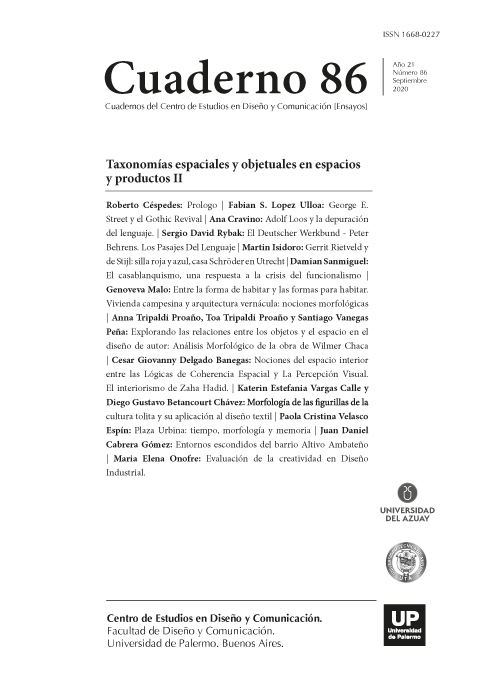Entornos escondidos del barrio Altivo Ambateño.
Abstract
The research presents the social component of the neighborhood called 'Altivo Ambateño' in Ambato-Ecuador, by showing the interior of some local craft shops. These interiors may be considered as perceptive or visual spaces that emanate intrinsec spatial and temporary meanings. Boontham (2015) describes the interior spaces of NakameguroJapan as hidden creative milieus, and establishes them as expressions at different scales that tend to be culturally specific. So in that way, the shops will be analyzed morphologycally through the visual organization laws (Reinante, 2014); structural and textural categories and harmonic chains (Pokropek, 2018) and identity makings (Castells, 1997), for understanding behaviors, functions and meanings that denote particular characteristics of the neighborhood's performers, for showing place strenghts and for finding relationships related to the imaginary. The british newspaper The Guardian describes neighborhoods from Poland, Argentina and Japan, among others, highlighting the social components and establishing a relationship between the spatial logics within the individual and the environment, so it describes Tokyo's shops as a creative milieus that overlap commercial and urban zones.
References
Barker, V. (2009, Enero 3). The Guardian. Retrieved Enero 29, 2019 from Streets ahead: https://www.theguardian.com/travel/2009/jan/03/buenos-aires-culture-rough-guide
Boontharm, D. (2015). The significance of interior space in the expression of Tokyo´s creative milieu.
Calduch, J. (2014). Temas de composición arquitectónica. 5. Forma y percepción. ECU. Clarin. (2007, Septiembre 14). Retrieved Enero 29, 2019 from La defensoría del pueblo porteña solicitó una investigación.: https://www.clarin.com/ediciones-anteriores/cuestionanlegal-llamar-palermo-queens-villa-crespo_0_rkOVsJk0Yx.html
Colegio24hs. (2004). Aristóteles. Colegio24hs.
Cornejo Parolini, L. (2012). El espacio común: nuevas aportaciones a la terapia gestáltica aplicada a la infancia y la adolescencia. Editorial Desclée de Brouwer.
Cresswell, P. (2008, Octubre 18). The Guardian. Retrieved Enero 29, 2019 from Streets ahead: https://www.theguardian.com/travel/2008/oct/18/krakow-weekends-streetsahead
Daou, D., Huppatz, D., & Phuong, D. Q. (2015). Unbounded: On the Interior and Interiority. Cambridge Scholars Publishing.
Hopkins, J. (2011). Manuales de diseño de moda: ropa de hombre. Editorial Gustavo Gili. Joe, M. (2008, Noviembre 15). The Guardian. Retrieved Enero 29, 2019 from Streets ahead: https://www.theguardian.com/travel/2008/nov/15/shopping-dining-tokyo-nakameguro
Jones, G. (2010). Beauty Imagined: A History of the Global Beauty Industry. Oxford University Press.
Menges, A. (2006). Michael Hensel; Frei Otto;. Architectural design, 76: 78-87.
Oluwatoni Asojo, A., & Taiwo Asojo, T. (2015). The influence of indigenous forms, art, and symbols on sacred spaces: A study of two catholic churches in Nigeria. Journal of Interior Design, 40(1), 1-17.
Palomar Vozmediano, J. (2012). Etimologias filosoficas. Retrieved from http://etimologiaspalomar.blogspot.com/2012/07/ousia.html
Pokropek, J. (2020). Lógicas de coherencia para la interpretación y producción del diseño interior y sus criterios de selección de formas objetuales. Cuaderno 81.
Quincy, T. (2013). Cutting along the Color Line. Black Barbers and Barber Shops in America. University of Pennsylvania Press.
Reinante, C. M. (2014). Morfología y espacio. Ediciones UNL.
Riello, G. (2012). Breve historia de la moda: desde la Edad Media hasta la actualidad. Editorial Gustavo Gili. Sacristán Romero, F. (2005). Reflexiones sobre la terapia Gestalt.
Santibáñez, D. (2006). Investigación social y autorreferencia. Sistemas sociales y sistemas psíquicos como sistemas autorreferenciales. Red Cinta de Moebio.
Schumacher, P. (2011). The Autopoiesis of Architecture : A New Framework for Architecture. (1 ed.). John Wiley & Sons, Incorporated.
Zarzar, K. M., & Guney, A. (2008). Understanding Meaningful Environments : Architectural Precedents and the Question of Identity in Creative Design. IOS Press.
Los autores/as que publiquen en esta revista ceden los derechos de autor y de publicación a "Cuadernos del Centro de Estudios de Diseño y Comunicación", Aceptando el registro de su trabajo bajo una licencia de atribución de Creative Commons, que permite a terceros utilizar lo publicado siempre que de el crédito pertinente a los autores y a esta revista.


